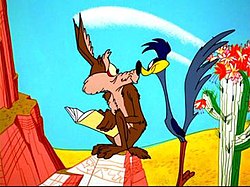 Photo of a coyote from Wikipedia.
Photo of a coyote from Wikipedia.Coyotes around here are not usually very big, but on average may be 34 inches long w/o tail and weight from 15 to 46 pounds. If you want to creep out: They have been known to be five foot long and weight up to 75 lbs. And forget about out running them: In pursuit, they can reach speeds of 43 mph and jump a distance of 13 feet. They can climb a fifteen foot chain link fence if hungry enough.
Most are in a pack of six but they tend to hunt in pairs. They can dig dens or use dens and burrows of other animals. They stick to a territory using the same paths (swell, I suppose we are now on one of their territorial paths.) Their life cycle is usually ten years but can live longer and actually can be trained in captivity. No thanks!!
Coyotes are mostly nocturnal but only because it's easier to hunt when humans aren't out and about. Thet average six pups per litter; typically only half survive.
I found the following: "When a coyote calls his pack together, he howls at one high note. When the pack is together, he howls higher and higher, and then they yip and yelp and also do a yi-yi sound very shrill with the howl." Sooooo, that's what this orchestra of caterwauling has been - just a little conversation between the family.
Mostly carnivores, they are opportunist as to what and where they find food. In the winter, they will also eat fruit and vegetables. Items like garbage, pet food, and sometimes feeding stations for birds and squirrels will attract coyotes into backyards. Yes, they prefer wild meat (especially rodents) but are not above attacking cats and smaller dogs. A pack, in the wild, can pursue a deer (or other larger animals) for up to 21 hours until the animal is exhausted. The population explosion in the Midwest is because the Midwest does not have the natural predictors of the coyote (wolf and cougars).
The good news: Attacks on humans are few because the coyotes are so much smaller and are typically afraid of adults humans. They have been known to stalk small children in urban areas. They cause the most domestic cat, sheep, goat and cattle losses of any predictor in the Midwest.
 Wile E. Coyote nose-to-nose with the Road Runner. And with that, I'll say that enough said about the coyote and "Beep Beep".
Wile E. Coyote nose-to-nose with the Road Runner. And with that, I'll say that enough said about the coyote and "Beep Beep".///--*--\\\
Here's a good hint to do every Fall when Daylight Savings Time ends:
- Change the batteries in your smoke and CO detectors
- Check the batteries in your flashlights and radios. (keep an extra supply of batteries for emergencies)
- Put emergency supplies in your vehicles:
- Bag of Kitty Litter, flashlight, flares, ice scraper, blanket, power bars and always take a fully charged cell phone.
- Plug in the cat and dog water heater bowls and make sure they have warm dry bedding protected from wind and rain/snow. (Bring them in a protected warm area if the temps get too cold.)
- Start your snow plow, generator, snow blower and make sure they are fueled and ready to go.
- Have enough extra fuel on hand to last through a prolonged outage.
No comments:
Post a Comment